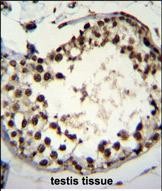ASXL1 Antibody (Center)
Affinity Purified Rabbit Polyclonal Antibody (Pab)
- SPECIFICATION
- CITATIONS
- PROTOCOLS
- BACKGROUND

Application
| WB, IHC-P, IF, FC, E |
|---|---|
| Primary Accession | Q8IXJ9 |
| Other Accession | P59598, NP_056153.2 |
| Reactivity | Human, Mouse |
| Host | Rabbit |
| Clonality | Polyclonal |
| Isotype | Rabbit IgG |
| Calculated MW | 165432 Da |
| Antigen Region | 521-549 aa |
| Gene ID | 171023 |
|---|---|
| Other Names | Putative Polycomb group protein ASXL1, Additional sex combs-like protein 1, ASXL1, KIAA0978 |
| Target/Specificity | This ASXL1 antibody is generated from rabbits immunized with a KLH conjugated synthetic peptide between 521-549 amino acids from the Central region of human ASXL1. |
| Dilution | WB~~1:1000 IHC-P~~1:50~100 IF~~1:10~50 FC~~1:10~50 E~~Use at an assay dependent concentration. |
| Format | Purified polyclonal antibody supplied in PBS with 0.09% (W/V) sodium azide. This antibody is purified through a protein A column, followed by peptide affinity purification. |
| Storage | Maintain refrigerated at 2-8°C for up to 2 weeks. For long term storage store at -20°C in small aliquots to prevent freeze-thaw cycles. |
| Precautions | ASXL1 Antibody (Center) is for research use only and not for use in diagnostic or therapeutic procedures. |
| Name | ASXL1 |
|---|---|
| Synonyms | KIAA0978 |
| Function | Probable Polycomb group (PcG) protein involved in transcriptional regulation mediated by ligand-bound nuclear hormone receptors, such as retinoic acid receptors (RARs) and peroxisome proliferator-activated receptor gamma (PPARG) (PubMed:16606617). Acts as a coactivator of RARA and RXRA through association with NCOA1 (PubMed:16606617). Acts as a corepressor for PPARG and suppresses its adipocyte differentiation-inducing activity (By similarity). Non- catalytic component of the PR-DUB complex, a complex that specifically mediates deubiquitination of histone H2A monoubiquitinated at 'Lys-119' (H2AK119ub1) (PubMed:20436459, PubMed:30664650, PubMed:36180891). Acts as a sensor of N(6)-methyladenine methylation on DNA (6mA): recognizes and binds 6mA DNA, leading to its ubiquitination and degradation by TRIP12, thereby inactivating the PR-DUB complex and regulating Polycomb silencing (PubMed:30982744). The PR-DUB complex is an epigenetic regulator of gene expression and acts as a transcriptional coactivator, affecting genes involved in development, cell communication, signaling, cell proliferation and cell viability (PubMed:30664650, PubMed:36180891). ASXL1, ASXL2 and ASXL3 function redundantly in the PR-DUB complex (By similarity) (PubMed:30664650). The ASXL proteins are essential for chromatin recruitment and transcriptional activation of associated genes (By similarity). ASXL1 and ASXL2 are important for BAP1 protein stability (PubMed:30664650). Together with BAP1, negatively regulates epithelial-mesenchymal transition (EMT) of trophoblast stem cells during placental development by regulating genes involved in epithelial cell integrity, cell adhesion and cytoskeletal organization (PubMed:34170818). |
| Cellular Location | Nucleus. |
| Tissue Location | Widely expressed at low level. Expressed in heart, brain, skeletal muscle, placenta, pancreas, spleen, prostate, small intestine, colon, peripheral blood, leukocytes, bone marrow and fetal liver. Highly expressed in testes. |

Thousands of laboratories across the world have published research that depended on the performance of antibodies from Abcepta to advance their research. Check out links to articles that cite our products in major peer-reviewed journals, organized by research category.
info@abcepta.com, and receive a free "I Love Antibodies" mug.
Provided below are standard protocols that you may find useful for product applications.
Background
This gene is similar to the Drosophila additional sex combs gene, which encodes a chromatin-binding protein required for normal determination of segment identity in the developing embryo. The protein is a member of the Polycomb group of proteins, which are necessary for the maintenance of stable repression of homeotic and other loci. The protein is thought to disrupt chromatin in localized areas, enhancing transcription of certain genes while repressing the transcription of other genes. The protein encoded by this gene functions as a ligand-dependent co-activator for retinoic acid receptor in cooperation with nuclear receptor coactivator 1. Mutations in this gene are associated with myelodysplastic syndromes and chronic myelomonocytic leukemia. Alternative splicing results in multiple transcript variants.
References
Abdel-Wahab, O., et al. Leukemia 24(9):1656-1657(2010)
Szpurka, H., et al. Leuk. Res. 34(8):969-973(2010)
Sugimoto, Y., et al. Br. J. Haematol. 150(1):83-87(2010)
Boultwood, J., et al. Leukemia 24(6):1139-1145(2010)
Rocquain, J., et al. BMC Cancer 10, 401 (2010) :
If you have used an Abcepta product and would like to share how it has performed, please click on the "Submit Review" button and provide the requested information. Our staff will examine and post your review and contact you if needed.
If you have any additional inquiries please email technical services at tech@abcepta.com.













 Foundational characteristics of cancer include proliferation, angiogenesis, migration, evasion of apoptosis, and cellular immortality. Find key markers for these cellular processes and antibodies to detect them.
Foundational characteristics of cancer include proliferation, angiogenesis, migration, evasion of apoptosis, and cellular immortality. Find key markers for these cellular processes and antibodies to detect them. The SUMOplot™ Analysis Program predicts and scores sumoylation sites in your protein. SUMOylation is a post-translational modification involved in various cellular processes, such as nuclear-cytosolic transport, transcriptional regulation, apoptosis, protein stability, response to stress, and progression through the cell cycle.
The SUMOplot™ Analysis Program predicts and scores sumoylation sites in your protein. SUMOylation is a post-translational modification involved in various cellular processes, such as nuclear-cytosolic transport, transcriptional regulation, apoptosis, protein stability, response to stress, and progression through the cell cycle. The Autophagy Receptor Motif Plotter predicts and scores autophagy receptor binding sites in your protein. Identifying proteins connected to this pathway is critical to understanding the role of autophagy in physiological as well as pathological processes such as development, differentiation, neurodegenerative diseases, stress, infection, and cancer.
The Autophagy Receptor Motif Plotter predicts and scores autophagy receptor binding sites in your protein. Identifying proteins connected to this pathway is critical to understanding the role of autophagy in physiological as well as pathological processes such as development, differentiation, neurodegenerative diseases, stress, infection, and cancer.





